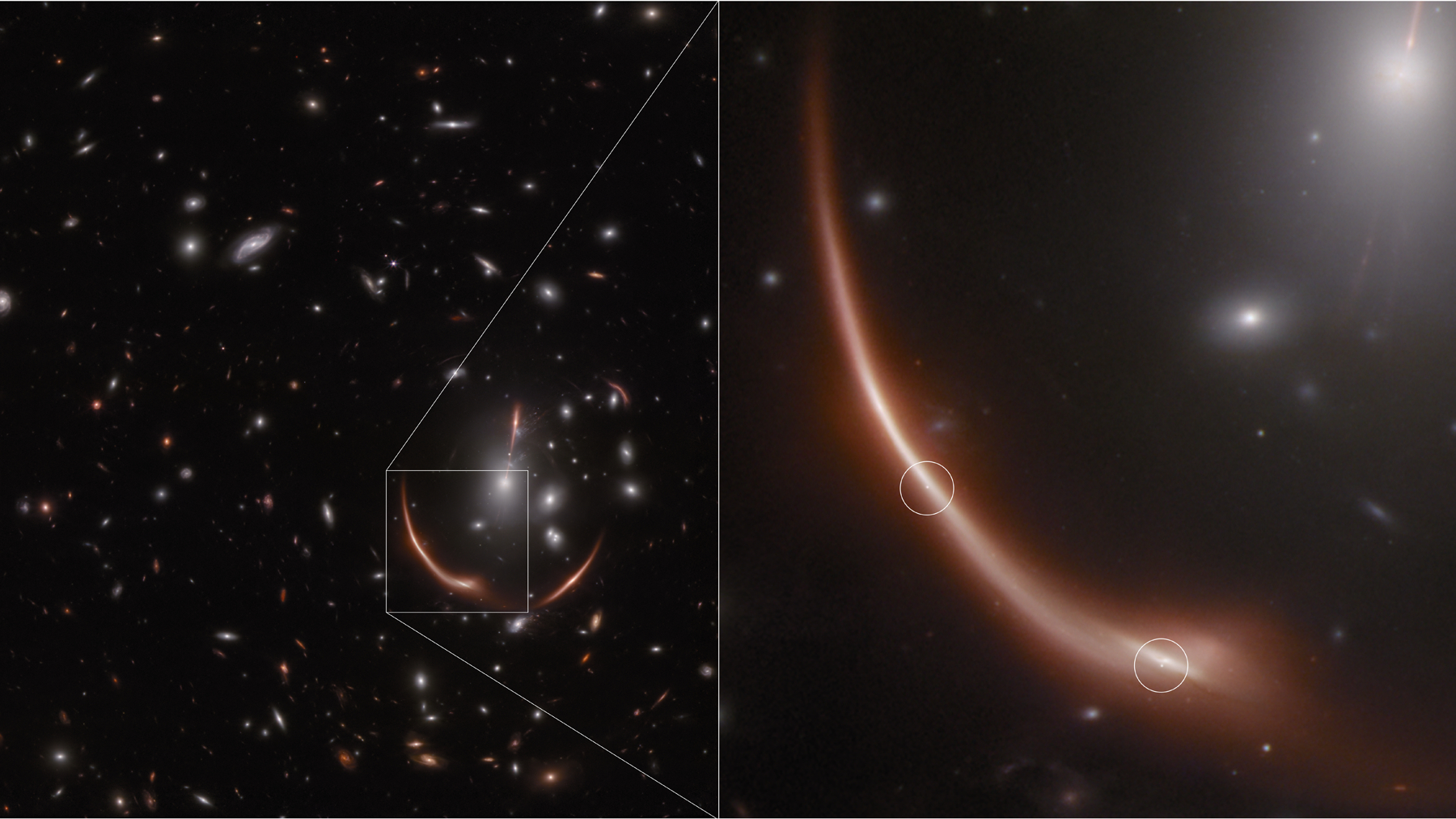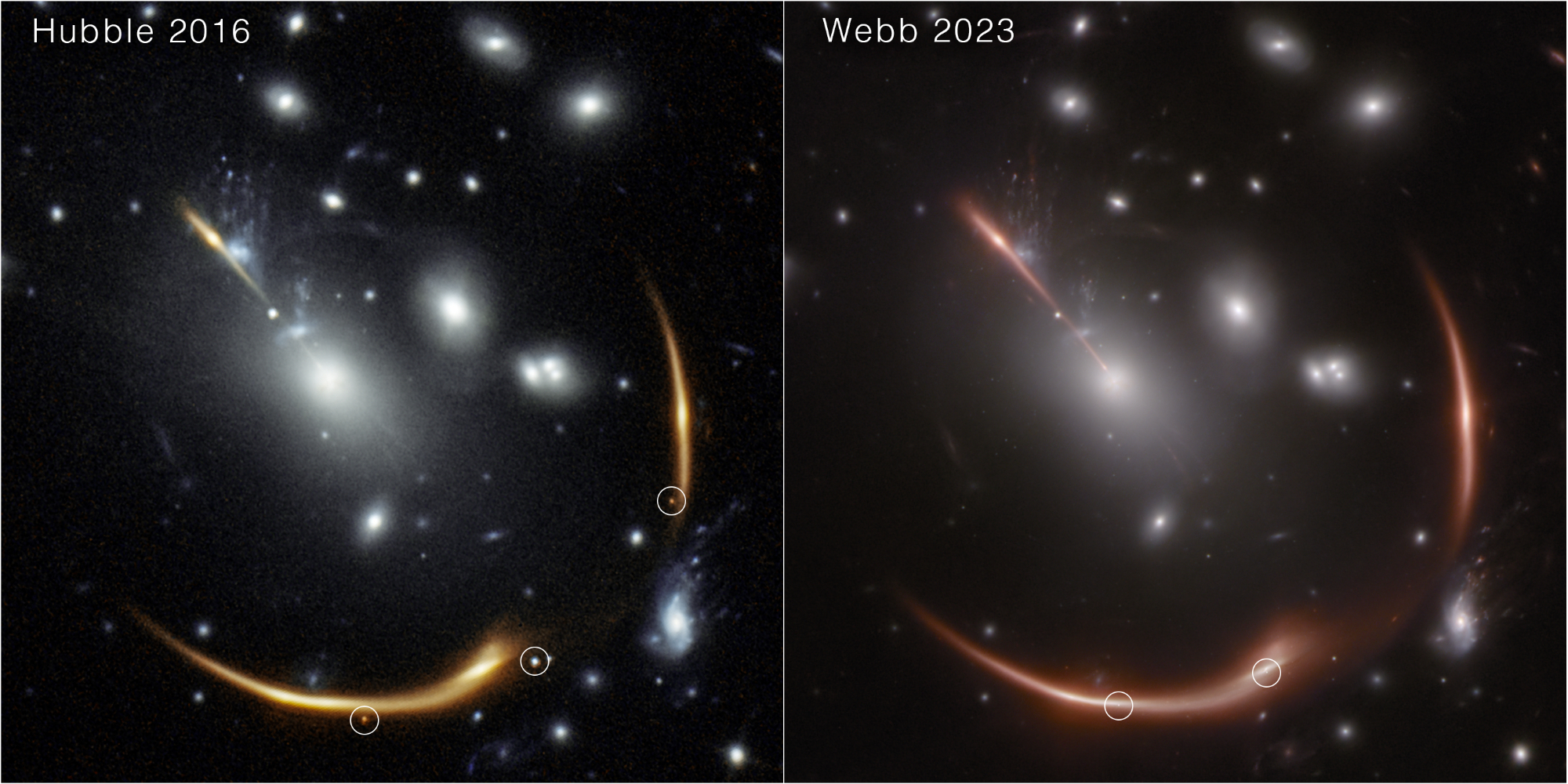
Two supernovas in a galaxy, and one that's so utterly far away that we see it as it was 10 billion years ago, could be vital in helping reveal the expansion rate of the universe. This is a measurement that has rather created some tension among the scientific community.
The galaxy and the two supernovas were imaged by the Hubble and James Webb space telescopes. The galaxies are made visible by the power of gravitational lensing — a phenomenon in which large amounts of mass, such as what's found in a galaxy cluster, can warp space into a "lens" shape that can then magnify and distort the light of more distant galaxies.
In 2016, the Hubble Space Telescope imaged the galaxy MRG-M0138, but the images were not fully analyzed until three years later. MRG-M0138's light is being distorted into five separate images by the lens of the galaxy cluster MACS J0138.0-2155, which is 4 billion light-years away from us. The images don't exactly look like galaxies we're familiar with seeing because they are being warped into arcs by the imperfect lens situation.
However, when studying the Hubble images in 2019, astronomers noted the bright light of a supernova in MRG-M0138. A type Ia supernova is the explosion of a white dwarf, either through colliding with another white dwarf or by stealing enough matter from a close companion star.
But now, astronomers observing MRG-M0138 with the James Webb Space Telescope (JWST) have discovered a second type Ia supernova in the distant galaxy.
The first supernova was nicknamed "Requiem"; this second supernova has been called "Encore." MRG-M0138 is the most distant galaxy to be seen with two type Ia supernovae, and in fact, that's very important for helping to solve what is possibly the greatest puzzle in cosmology right now.
When astronomers measure the expansion rate of the universe — a quantity we call the Hubble constant — they get two incompatible values. Although on the face of it, there seems to be no error with either measurement, both of them obviously cannot be correct. So, either there is an undetected error in our measurements, or there is exotic new physics at play.
One means of measuring the Hubble constant is through analysis of the cosmic microwave background (CMB) radiation left behind by the Big Bang. The CMB is mottled by tiny temperature differences that equate to variations in the density of primordial matter that grew into the galaxies and galaxy clusters that we see today. These variations and large-scale structures we see in the universe today are directly related, and based on what we know of the standard model of cosmology, astronomers are able to use this connection to derive a value of the Hubble constant equal to 67.4 kilometers (41.9 miles) per second per megaparsec. (A megaparsec is 3.26 million light years, so what this means is that every second, any given volume of space 3.26 million light years in diameter is expanding by 67.4 kilometers.)

However, Type Ia supernovas are also useful for measuring cosmic distances — and the Hubble constant. That's because they have a standardizable maximum luminosity from which we can judge their true intrinsic luminosities Then, based on how bright or faint they appear to us, we can calculate how distant they must be. From there, astronomers can compare this distance with the supernova's redshift, which is a measure of how fast space is expanding and therefore stretching the wavelengths of light emanating from the supernova — to get the Hubble constant. The final calculation is done using the Hubble–Lemaître law, which says the recession velocity is equal to the distance multiplied by the Hubble constant. Using this method, astronomers calculate 73.2 kilometers (45.5 miles) per second per megaparsec, which is larger than the CMB-derived value.
However, the lensed supernovas in MRG-M0138 have an extra advantage in that they will appear in five different lensed images of the galaxy.
"When a supernova explodes behind a gravitational lens, its light reaches Earth by several different paths," said Justin Pierel of the Space Telescope Science Institute and Andrew Newman of the Observatories of the Carnegie Institution for Science in a joint statement.
These paths are of different lengths, so the supernova can appear in the images separated by days, weeks, even years.
"By measuring differences in the times that the supernova images appear, we can measure the history of the expansion rate of the universe, known as the Hubble constant, which is a major challenge in cosmology today," Pierel and Newman said.
Lensed supernovas are rarely found, with less than a dozen known. This makes the two type Ia supernovae in MRG-M0138 exceptionally valuable.
However, there's a catch. While most of the images of the two supernovas have appeared, one of the light paths is predicted to be much longer, based on models of the distribution of dark matter in the lensing cluster. Those final images are not expected to appear until the mid-to-late 2030s.
"Supernovae are normally unpredictable, but in this case we know when and where to look to see the final appearances of Requiem and Encore," said Pierel and Newman. "Infrared observations around 2035 will catch their last hurrah and deliver a new and precise measurement of the Hubble constant."
While the aging Hubble Space Telescope might not still be active in 2035, hopefully the JWST will still be. If it is, and if it can detect the appearance of the final images from Requiem and Encore, the measurement of the Hubble constant that they provide could help settle the matter of whether so-called Hubble tension is merely experimental error or a real phenomenon.







